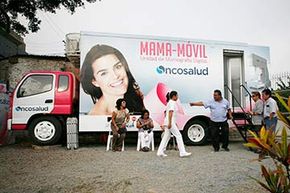Remember when we used to be tethered to phones with those annoying cords, forced to change channels manually and actually visit the doctor's office? O.K, so we still need to do the latter quite a lot, but times are a-changing, thanks to the way that the medical industry constantly evolves to meet patient needs. In a world where convenience is certainly the name of the game, everything seems to be either wireless or on wheels. Mobile medicine has jumped on this bandwagon with great fervor in two ways. Patients can connect with doctors via portable medical facilities, which can be set up as needed, or use the Internet to talk with a health care provider.
Mobile medicine is designed to meet the needs of people who can't or don't like traveling to the doctor. From a prevention perspective, getting people in touch with primary care physicians and specialists is more important than ever. Stopping problems before they start or spotting them in their earliest stages can dramatically impact longevity and quality of life. Nearly half of adults suffer from some type of chronic disease, with seven out of 10 American deaths each year blamed on illnesses such as cancer or heart disease, which often can be managed or treated successfully if caught early enough [source: CDC].
Advertisement
For many people, gaining access to checkups or screenings is easier said than done. Some are uninsured, lack transportation or live in rural or impoverished communities. Others are simply too busy to schedule time to take care of themselves. Enter mobile medicine, which is designed to take any speck of inconvenience from the picture, showing up on your doorstep (or at least pretty close by). These services, apps and other tech offerings are embraced by many companies and insurance plans that recognize the long-term potential benefits of wellness checkups, screenings and prompt attention in emergency situations.
Are you intrigued, but not totally clear about the whole concept of mobile health care? Keep reading to learn more about the ways you can take advantage of this emerging industry.
Advertisement





